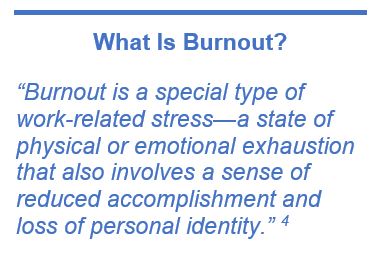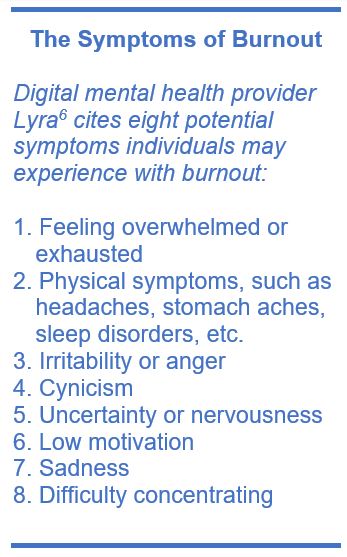Don’t Ignore HR Burnout

Caring for Your Organization’s Caregivers
Nearly three in four employees (74%) say that they’ve found themselves feeling burned out at some point in their careers, according to recent research1 by Gallup. And a study2 by Indeed reported that two-thirds of workers believe that burnout has worsened since the COVID-19 pandemic.
With the number of employees quitting their jobs reaching a record 3 high of 4.5 million in March 2022, and ongoing employer concerns about sufficient pools of new talent, it has never been more important for organizations to pay close attention to the well-being of their workforces.
But when companies turn to their human resources (HR) functions for help with employee retention, applicant attraction, and well-being issues like burnout, many are finding that HR professionals are in even more dire straits than the broader workforce.
HR Is in Trouble
Recently, Forbes5 reported that a survey of more than 500 U.S. and UK HR professionals found a whopping 98% acknowledging that they were burned out. Nearly as many (97%) said that, over the past year, their work left them feeling emotionally fatigued. Further...
| • | 94% of the survey respondents admitted that they’d felt overwhelmed during the last six months |
| • | 88% said they dreaded work |
| • | only 29% felt their employers valued their work, despite the fact that many felt pressured to address organizational changes and talent issues |
| • | nearly eight in 10 (78%) reported being open to pursuing new jobs elsewhere |


In the lingering wake of the pandemic, many organizations continue to struggle with business challenges for which they rely on HR to take the lead or help address: shifting company cultures, new hybrid work models, worker demands for greater flexibility, heightened attrition, and stiff competition for new talent.
Because burnout (and its attendant ill effects on engagement, motivation, absenteeism, productivity, and more) is widely impacting employees outside the HR function, too, increased needs for mental health and wellness interventions have become pressing. In turn, company leaders look to HR for solutions to those challenges as well.
Stopping the Vicious Cycle
Talent expert Gillian French, whose firm fielded the HR survey, told Forbes, “HR and internal communications are tasked with taking care of employees and ensuring that everybody else feels appreciated, recognized and healthy in the workplace. These professionals should also feel this in order to create a healthier workplace and solve internal issues.”
What can organizations—and HR professionals, themselves—do to help relieve burnout? Although there are no easy fixes to such a serious situation, here are some suggestions that may aid in reducing stress levels in HR (and companywide):
Organizations can:
| 1. | Give HR a voice by including HR leadership—along with other business functional leaders—in organizational planning and decision-making. |
| 2. | Ensure that HR has sufficient staff and resources to handle increased demands and expectations effectively. |
| 3. | Prioritize engagement of and support for HR leaders and staff, emphasizing flexibility, autonomy, open communications, and senior leaders’ attention. |
| 4. | Encourage HR professionals (and all employees) to prioritize their own well-being by opening dialogues about physical and mental well-being and reinforcing communication of available well-being programs and benefits. Ensure that well-being programming specifically addresses burnout. |
| 5. | Offer occasional structured time off (such as half-day Fridays during summer months) when the entire workforce can step away. Or increase paid time off (PTO) to enable HR and other employees to have ample time to rest and de-stress. |
HR professionals can:
| 1. | Recognize that they must take care of themselves first if they are to provide effective care for employees. Follow through with actions that enable work-life balance, such as taking advantage of flexibility in work location or scheduling, avoiding emails after work hours, etc. |
| 2. | Incorporate stress management activities into the work day by taking breaks, walking outdoors at lunchtime, blocking regular calendar time to limit availability, or participating in organizational stress-relief programs (such as timeouts for mindfulness/meditation, in-person or virtual team social events, reflection time, etc.). |
| 3. | Schedule and take PTO. Long weekends or periodic vacations can help ease the physical and emotional exhaustion of burnout. |
| 4. | Seek support from physical and/or mental health professionals when needed to combat burnout effectively. Many organizations offer telehealth and tele-counseling benefits and apps that provide access to care 24/7. |
| 5. | Team with colleagues to make HR a great place to work. Involve all HR staff in creating a culture within the HR function that emphasizes respect, healthy collaboration, flexibility, and well-being for all. |
Burnout is a serious problem for many organizations and employees – especially those in HR who take their jobs as workforce caregivers seriously. Relieving burnout requires empathy and action on the part of organizational leaders and employees, alike.
Digital mental health care provider Lyra6 advises creating a solid foundation with a company culture that centers on well-being, reminding leaders: “It’s important to react to employee distress with empathy and care, but it’s equally important to create conditions in the workplace that reduce the risk of burnout. Ask yourself, ‘How can I make this a healthy environment for employees to come to every day?’”
TRAINING RECOMMENDATION
By ensuring a workplace of respect, where people look out for one another, you can lessen stress and burnout. Here are Media Partners' top training programs in this area:
1 Gallup - https://www.gallup.com/workplace/353831/eliminate-burnout-retain-top-talent.aspx
2 Indeed - https://www.indeed.com/lead/preventing-employee-burnout-report
3 CNN - https://www.cnn.com/2022/05/03/economy/job-openings-quits-march/index.html
4 Mayo Clinic - https://www.mayoclinic.org/healthy-lifestyle/adult-health/in-depth/burnout/art-20046642
5 Forbes - https://www.forbes.com/sites/jackkelly/2022/04/14/98-of-human-resources-professionals-are-burned-out-study-shows/?sh=186f95776c02
6 Lyra - https://get.lyrahealth.com/rs/359-GQR-502/images/LYRA-Combatting-Work-Fatigue-Guide.pdf?mkt_tok=MzU5LUdRUi01MDIAAAGEXdenrnMPb0vEqAyRs731Nx5FQuIACDUSECw20lDl8sJoxSp0aiyTIM3yzsrWKL46KgBSXhUOEVlJdk5vMsK6lM99D4jewtOMDE9innBg%C2%A0%C2%A0









